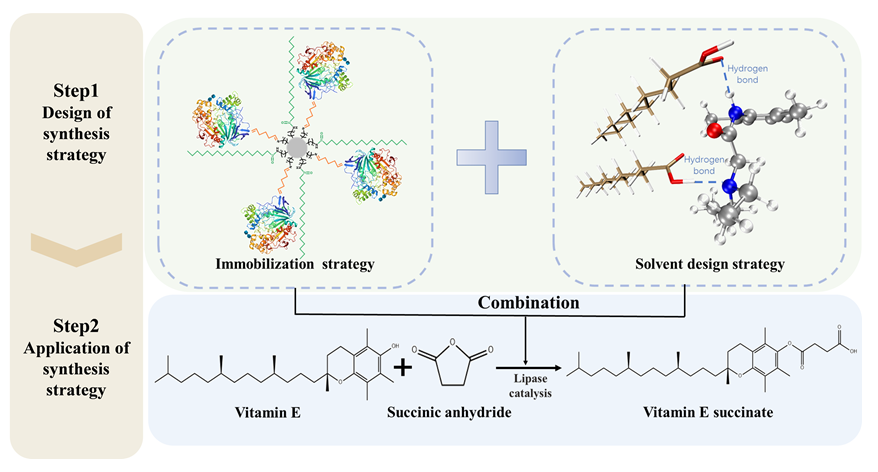

Study on the Mechanism of Synergistic Enhancement of Lipase Efficiency in Vitamin E Succinate Synthesis through Immobilization and Solvent Design Strategies
Received date: 2024-10-29
Online published: 2025-02-05
Supported by
National key R&D program of China(2021YFC2103800); National Natural Science Foundation of China(22178174); Jiangsu Synergetic Innovation Center for Advanced Bio-Manufacture(XTC2206)
Vitamin E is one of the most widely used antioxidants, extensively applied in the medical and food industries. However, its susceptibility to oxidation poses significant challenges during production, storage, and transportation. In recent years, a derivative of Vitamin E—Vitamin E succinate (VES) has garnered increasing attention. VES not only retains the biological functions of Vitamin E but also exhibits excellent stability and unique anti-tumor properties. The main methods for preparing VES include chemical synthesis and enzymatic synthesis. Enzymatic synthesis has become a popular research topic due to its environmental friendliness and high efficiency. Nevertheless, the high cost and poor reusability of free enzymes severely limit the industrial application of this method. Designing enzyme-friendly solvents and immobilized enzyme technologies has proven to be effective strategies to overcome these limitations. In this study, the synthesis of VES was employed as a model reaction to integrate immobilization and solvent design strategies. The lipase was immobilized in a dual-functional macroporous resin, combined with a novel deep eutectic solvent, significantly enhancing the performance of lipase. Under the optimal conditions, the experimental results revealed a VES yield of 99.3%. When scaled up tenfold, the system achieved a 99.1% esterification yield, with the catalytic activity remaining above 80.0% even after five reuse cycles. Notably, molecular dynamics simulation results indicated that the deep eutectic solvent has excellent biocompatibility, which enhances the stability and reusability of lipase. Furthermore, this solvent improves the affinity of lipase for the substrate, thereby increasing the yield of VES. The synthetic strategy developed in this study is environmentally friendly, catalytically efficient, and offers broad applications in the field of biosynthesis.

Key words: lipase; immobilization; vitamin E succinate; deep eutectic solvent; biocatalysis
Zihan Zhang , Guangzheng Ma , Binbin Nian , Yi Hu . Study on the Mechanism of Synergistic Enhancement of Lipase Efficiency in Vitamin E Succinate Synthesis through Immobilization and Solvent Design Strategies[J]. Acta Chimica Sinica, 2025 , 83(2) : 119 -125 . DOI: 10.6023/A24100326
| [1] | Zaaboul, F.; Liu, Y. F. Compr. Rev. Food Sci. Food Saf. 2022, 21, 964. |
| [2] | Galli, F.; Azzi, A.; Birringer, M.; Cook-Mills, J. M.; Eggersdorfer, M.; Frank, J.; Cruciani, G.; Lorkowski, S.; ?zer, N. K. Free Radic. Biol. Med. 2017, 102, 16. |
| [3] | Ma, G. Z.; Chong, W. Y.; Qi, Y.; Lu, Z. P.; Zhang, Z. H.; Nian, B. B.; Hu, Y. Bioprocess. Biosyst. Eng. 2023, 46, 1695. |
| [4] | Zheng, L. L.; Wang, Y. Q.; Li, X. G.; Zhang, W. B. Chin. J. Org. Chem. 2022, 42, 3714. |
| [5] | Zhang, C.; Zhang, L. J.; Zhang, Y.; Huang, H.; Hu, Y. Acta Chim. Sinica 2016, 74, 74 (in Chinese). |
| [5] | (张川, 张鲁嘉, 张洋, 黄和, 胡燚, 化学学报, 2016, 74, 74.) |
| [6] | Nian, B. B.; Li, X. Int. J. Biol. Macromol. 2022, 217, 255. |
| [7] | Gao, F. Q.; Liu, Y.; Zhang, Y. L.; Jiang, Y. C. Acta Chim. Sinica 2023, 81, 338 (in Chinese). |
| [7] | (高丰琴, 刘洋, 张引莉, 蒋育澄, 化学学报, 2023, 81, 338.) |
| [8] | Durand, E.; Lecomte, J.; Villeneuve, P. Eur. J. Lipid Sci. Technol. 2013, 115, 279. |
| [9] | Ma, G. Z.; Zhang, Z. H.; Lu, Z. P.; Qi, Y.; Nian, B. B.; Hu, Y. J. Mol. Liq. 2024, 394, 10. |
| [10] | Qi, Y.; Zhang, Z.; Liu, Y.; Liang, C.; Chong, W.; Nian, B.; Hu, Y. J. Agric. Food Chem. 2024, 72, 23401. |
| [11] | Ma, G. Z.; Zhang, Z. H.; Chen, M.; Zhang, Y. F.; Nian, B. B.; Hu, Y. J. Sci. Food Agric. 2024, 104, 2669. |
| [12] | Datta, S.; Christena, L. R.; Rajaram, Y. R. S. 3 Biotech. 2013, 3, 1. |
| [13] | Ismail, A. R.; Baek, K. H. Int. J. Biol. Macromol. 2020, 163, 1624. |
| [14] | Rodrigues, R. C.; Berenguer-Murcia, A.; Carballares, D.; Morellon-Sterling, R.; Fernandez-Lafuente, R. Biotechnol. Adv. 2021, 52, 37. |
| [15] | Zhang, Y. F.; Ma, G. Z.; Wang, S. S.; Nian, B. B.; Hu, Y. J. Sci. Food Agric. 2023, 103, 7849. |
| [16] | Zhang, Z.; Zhang, Y.; Liu, Y.; Liang, C.; Nian, B.; Hu, Y. J. Agric. Food Chem. 2024, 72, 23345. |
| [17] | Goncalves, D.; Silva, A. G.; Guidini, C. Z. Appl. Microbiol. Biotechnol. 2019, 103, 7399. |
| [18] | Khan, Z.; Javed, F.; Shamair, Z.; Hafeez, A.; Fazal, T.; Aslam, A. J. Ind. Eng. Chem. 2021, 103, 80. |
| [19] | Maffucci, I.; Laage, D.; Sterpone, F.; Stirnemann, G. Chem.-Eur. J. 2020, 26, 10045. |
| [20] | Xia, J. J.; Bin, Z.; Zhou, R. Y. J. Sci. Food Agric. 2021, 101, 3186. |
| [21] | Jiang, X. J.; Hu, Y.; Jiang, L.; Gong, J. H.; Huang, H. Chem. Res. Chin. Univ. 2013, 29, 223. |
| [22] | Hou, X. Y.; Shi, Q. H. Chin. J. Chem. Eng. 2023, 62, 182. |
| [23] | He, W. S.; Zhu, H. Y.; Chen, Z. Y. J. Agric. Food Chem. 2018, 66, 3047. |
| [24] | Berendsen, H. J. C.; Vanderspoel, D.; Vandrunen, R. Comput. Phys. Commun. 1995, 91, 43. |
| [25] | Maier, J. A.; Martinez, C.; Kasavajhala, K.; Wickstrom, L.; Hauser, K. E.; Simmerling, C. J. Chem. Theory Comput. 2015, 11, 3696. |
| [26] | Trott, O.; Olson, A. J. J. Comput. Chem. 2010, 31, 455. |
| [27] | Humphrey, W.; Dalke, A.; Schulten, K. J. Mol. Graph. 1996, 14, 33. |
/
| 〈 |
|
〉 |